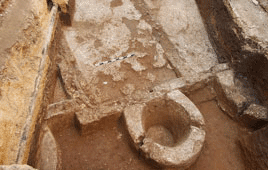Archaeological Discoveries: Ancient Industrial Installation Revealed in Jaffa
(February 2013)
Impressive remains of an industrial installation from the Byzantine period were discovered during archaeological excavations being conducted prior to modernizing infrastructure in Tel Aviv.
 |
The installation, which was most likely used to extract liquid, was exposed beneath Hai Gaon Street and provides a glimpse at hundreds of years of magnificent history Installations such as these are usually identified as wine presses for producing wine from grapes, and it is also possible they were used to produce wine or alcoholic beverage from other types of fruit that grew in the region. Jaffa's rich and diverse agricultural tradition has a history thousands of years old beginning with references to the city and its fertile fields in ancient Egyptian documents up until Jaffa's orchards in the Ottoman period.
"This is the first important building from the Byzantine period to be uncovered in this part of the city," said Dr. Yoav Arbel, director of the excavations on behalf of the Israel Antiquities Authority, "The fact that the installation is located relatively far from Tel Yafo adds a significant dimension to our knowledge about the impressive agricultural distribution in the region in this period."
Dr. Arble further noted that the installation, which probably dates to the second half of the Byzantine period (6th - 7th century CE), is divided into surfaces paved with a white industrial mosaic. Due to the mosaic's impermeability such surfaces are commonly found in the press installations of the period which were used to extract liquid. Each unit was connected to a plastered collecting vat. The pressing was performed on the mosaic surfaces whereupon the liquid drained into the vats.
It is possible that the section that was discovered represents a relatively small part of the overall installation, and other elements of it are likely to be revealed in archaeological excavations along adjacent streets which are expected to take place later this year.
Sources: Israel Ministry of Foreign Affairs


